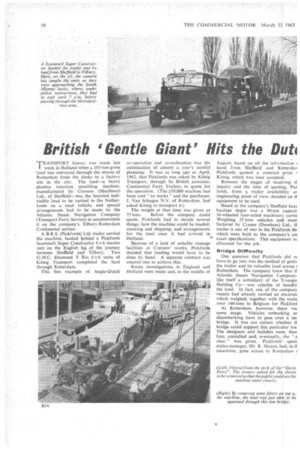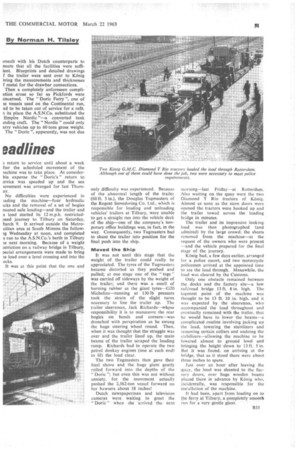British Gentle Giant' Hits the Dub eadlines
Page 52

Page 53

If you've noticed an error in this article please click here to report it so we can fix it.
TRANSPORT history was made last I week in Holland when a 103-ton-gross load was conveyed through the streets of Rotterdam from the docks to a factory site in the city. The load—a heavy plastics injection moulding machine, manufactured by Cravens (Machines) Ltd., of Sheffield—was the heaviest indivisible load to be carried in the Netherlands on •a road vehicle, and special arrangements had to be made by the Atlantic Steam Navigation Company (Transport Ferry Service) to accommodate it on the company's Tilbury-Rotterdam Continental service.
A B.R.S. (Pickfords) Ltd. trailer carried the machine, hauled trhind a Pickfords Scammell Super Constructor 6 x 6 tractor unit on the English leg of the journey between Sheffield and Tilbury. Two G.M.C. Diamond T Rio 6 X 6 units of Konig Transport completed the haul through Rotterdam.
This fine example of Anglo-Dutch
co-operation and co-ordination was the culmination of almost a year's careful planning. It was as long ago as April, 1962, that Pickfords was asked by Konig Transport, through Its British associate, Continental Ferry Trailers, to quote for the operation. (The £50,000 machine had been sold ex works" and the purchaser, J. Van Schagen N.V. of Rotterdam, had asked Konig to transport it.)
The weight at• that time was given as 75 tons. Before the company could quote, Pickfords had to decide several things: how the machine could be loaded; routeing and shipping; and arrangements for the load once it had arrived in Holland.
Because of a lack of suitable cranage facilities at Cravens' works, Pickfords decided that loading would have to be done by hand. A separate contract was entered into to achieve this.
Route investigations in England and Holland were made and, in the middle of August, based on all the information hand from Sheffield and Rotterdan Pickfords quoted a contract price Ktinig, which was later accepted.
Between the stages of receiving ti inquiry and the time of quoting, Pic] fords, from a trailer availability au engineering point of view, decided on ti equipment to be used.
Based at the company's Sheffield hem haulage depot was a 90-ton capacit 16-wheeled four-axled machinery carrie Weighing 25 tons unladen and man factured by Cranes (Dereham) Ltd., ti trailer is one of two in the Pickfords fie which were built to the company's ort exact specifications. This equipment w allocated for the job.
Bridge Difficulty One question that Pickfords did m have to go into was the method of gettir the trailer and its valuable load across 1 Rotterdam. The company knew that ti Atlantic Steam Navigation Companylike itself a subsidiary of the Transpo Holding Co.—was capable of handlir the load. In fact, one of the company vessels had already carried an excavat( which weighed, together with the traile over 140 tons to Belgium for Pickford
At Rotterdam, however, there we: some snags. Vehicles embarking an disembarking have to pass over a ste bridge. It was not certain whether tt bridge could support this particular loa The designers and builders were, then fore, consulted and, eventually, the "a clear" was given. Pickfords' sped duties manager. Mr. R. Mason, had, in ti meantime, gone across to Rotterdam 1 onsult with his Dutch counterparts to nsure that all the facilities were suffiient. Blueprints and detailed drawings f the trailer were sent over to Konig iving the measurements and thicknesses f metal for the drawbar connections.
• Then a completely Unforeseen compilation arose so far as Pickfords were onceined. The "Done Ferry ", one of se vessels used on the Continental run, ad to be taken out of service for a refit. its place the A.S.N.Co. substituted the Empire Nordic "—a converted tank tnding craft_ The "Nordic" could only arry vehicles up to 60 tons gross weight. The "Doric ", apparently, was not due ) return to service until about a week fter the scheduled movement of the tachine was to take place. At considerble expense the " Doric's " return to .7.rvice was speeded up and the sea tovement was arranged for last Thursay.
No difficulties were experienced in )ading the machine—four hydraulic icks and the removal of a set of bogies nsured safe loading—and the trailer-and s load started its 12 m.p.h. restrictedpeed journey to Tilbury on Saturday, larch 9. It arrived outside the Metro°titan area at South Mitnms the followig Wednesday at noon, and completed s run to the A.S.N.Co.'s berth in Tilbury le next morning. Because of a weight :striction on a railway bridge in Tilbury, pecial arrangements were made to bring le load over a level crossing and into the ocks.
It was at this point that the one and only difficulty was experienced. Because of the abnormal length of the trailer (60 ft. 5 in.), the Douglas Tugmasters of the Regent Stevedoring Co. Ltd., which is responsible for loading and unloading vehicles' trailers at Tilbury, were unable to get a straight run into the vehicle deck of the ship—one of the company's temporary office buildings was, in fact, in the way. Consequently, two Tugmasters had to shunt the trailer into position for the final push into the ship.
Moved the Ship
It was not until this stage that the weight of the trailer could really be appreciated. The tyres of the Tugmasters became distorted as they pushed and pulled; at one stage one of the " tugs " was carried off sideways by the weight of the trailer; and there was a smell of• burning rubber as the giant tyres—G20 Michelins—running at 130 lb pressure took the strain of the slight turns necessary to line the trailer up. The trailer steersman, Jack Richards—whose responsibility it is to manceuvre the rear bogies on bends and corners—was drenched with perspiration as he swung the huge steering wheel round. Then, when it was thought that the struggle was over and the trailer lined up, the main beams of the trailer scraped the loading ramp. Richards had to operate the two petrol donkey engines (one at each end) to lift the load clear.
The two Tugmasters then gave their final shove and the huge giant gently rolled forward into the depths of the " Doric "; but even this was not without anxiety, for the movement actually pushed the 2,562-ton vessel forward on her hawsers about 18 inches!
Dutch newspapermen and television cameras were waiting to greet the " Doric " when she arrived the next morning—last Friday—at Rotterdam. Also waiting on the quay were the two Diamond T Rio tractors of Kiinig. Almost as soon as the stern doors were opened the tractors were hooked up and the trailer towed across the loading bridge in minutes.
The trailer and its impressive looking load was then photographed (and admired) by the large crowd; the sheets removed from the machine—at the request of the owners who were .present —and the vehicle prepared for the final stage of the journey.
Konig had, a few days earlier, arranged for a police escort, and two motorcycle policemen arrived at the appointed time to see the load through. Meanwhile, the load was cleared by the Customs.
Only one obstacle remained between the docks and the factory site—a -low rail/road bridge 13 ft. 8 in. high. The topmost point of the -machine was thought to be .13 ft. 10 in: high, and it was expected by the steersman, who accompanied the load throughout and eventually remained with the trailer, that he would have to lower the beams—a complicated routine involving jacking up the load, lowering the stabilizers and removing certain collars and undoing the stabilizers—allowing the machine to be lowered almost to ground level and bringing the height down to 13 ft. 5 in. But it was found, on arriving at the bridge, that as it stood there were about three inches to spare.
Just over an hour after leaving the quay, the load was shunted to the factory doors, over huge wooden beams placed there in advance by Konig who, incidentally, was responsible for the installation of the machine.
It had been, apart from loading on to the ferry at Tilbury, a completely smooth run for a very ientle 'giant. ' • '




































































































